

Berthon Winter Collection

Latest issue

August 2024
In the August 2024 issue of Yachting World magazine: News Few finish a tempestuous Round The Island Race European rules are eased for cruising to France and Greece Olympic sailing…

Yachting World
- Digital Edition

A pocket guide to the J Class yachts – the world’s most elegant racing fleet
- Toby Hodges
- March 19, 2017
Toby Hodges profiles the world's most beautiful fleet of classic racing yachts – the J Class
Shamrock V – JK3

J Class yacht Shamrock sailplan
LOA: 36.50m /119ft 9in · LWL: 26.7m/87ft 7in · Beam: 6.00m/19ft 8in · Disp: 166 tonnes
Original lines: Charles E Nicholson
Modified design: Dykstra Naval Architects
Launch year and yard: 1930, Camper & Nicholsons
Identifying features: The only wooden J and the smallest. Dark green hull with bronze deck fittings.
Current state: She has just had a refit in Palma after a long period under her past owner chartering, cruising and occasional racing.
Race prediction:Her smaller size means she will struggle against the other J Class yachts in real time – but she has the most experienced skipper and her recent mods are all aimed at making her competitive on handicap.
Skipper: Simon Lacey · Race Helmsman: Mike ‘Moose’ Sanderson

Photo: J Class Association / Gerhard Standop
Velsheda – JK7

J Class yacht Velsheda sailplan
LOA: 39.25m/128ft 9in · LWL: 27.8m/91ft 3in · Beam: 6.57m/21ft 7in · Disp: 180 tonnes
Launch year and yard: 1933, Camper & Nicholsons. Rebuilt by Southampton Yacht Services in 1997.
Identifying features: Dark blue hull, pinched transom and that iconic sharp J bow.
Current state: Continually optimised and very well prepared.
Race prediction: Highly experienced, well-gelled crew and a yacht that is looking particularly nimble and aggressive at the start. Despite surrendering size to the modern J Class yachts she’s a firm favourite to win any regatta.
Skipper: Barney Henshaw-Depledge · Race helmsman: Owner-driver
Helen Fretter goes racing on board J Class yacht Velsheda

Photo: J Class Association / Onne van der Wal
Endeavour – JK4

J Class yacht Endeavour sailplan
LOA: 39.31m/128ft 12in · LWL: 27.30m/89ft 7in · Beam: 6.68m/21ft 11in · Disp: 175 tonnes
Launch year and yard: 1934, Camper & Nicholson. Relaunched by Royal Huisman in 1989.
Identifying features: Royal ‘Endeavour Blue’ hull, clean deck, single deckhouse.
Current state: Completely refitted by Yachting Developments in 2010-11. Based between Palma and Cascais she is for sale through Edmiston and in prize condition.
Race prediction: Fully optimised and race ready, but is up for sale and now already unlikely to be ready in time for Bermuda.
Skipper: Luke Bines · Race helmsman: N/A (Torben Grael in 2012)
Video exclusive: what it’s like to sail the iconic J Class Endeavour

Photo: J Class Association / Jens Fischer
Ranger – J5

J Class yacht Ranger sailplan
LOA: 41.63m/136ft 7in · LWL: 28.80m/94ft 6in · Beam: 6.41m/21ft 0in · Disp: 203 tonnes
Original design: Starling Burgess and Olin Stephens
Modified design: Studio Scanu, Reichel Pugh, Fred Elliot and Dykstra Naval Architects
Launch year and yard: 2003, Danish Yacht
Identifying features: White hull with snub nose and spoon bow.
Current state: Refitted and optimised at Newport Shipyard 2016, where chainplates were moved forward and tracks modified to take a bigger headsail.
Race prediction: The heaviest J, but a rocket in flat water, such as in Bermuda’s Great Sound. A veteran crew whose consistency is Ranger’s trump card.
Skipper: Dan Jackson · Race helmsman: Erle Williams
Ranger J5 – the first completely new J Class yacht

Ranger , J5 RYS centenary 2015. Photo Paul Wyeth
Rainbow – JH2

J Class yacht Rainbow sailplan
LOA: 39.89m/130ft 11in · LWL: 26.90m/88ft 3in · Beam: 6.42m/21ft 1in · Disp: 167 tonnes
Original lines: William Starling Burgess
Launch year and yard: 2012, Holland Jachtbouw
Identifying features: Black hull, red bottom and modern grey rig with race boom.
Current state: Sold in 2015 by Chris Gongriep, the former owner of Holland Jachtbouw, she has since solely been used for cruising by her US owner who shows no signs of wanting to race, although she will be in Bermuda to watch.
Race prediction: Was cruised and raced extensively for a couple of seasons after she was built and has proven to be a supremely fast boat for her size in the right hands.
J Class yacht Rainbow – the Dutch destroyer
Hanuman – JK6

J Class yacht Hanuman sailplan
LOA: 42.19m/138ft 5in · LWL: 27.50m/90ft 3in · Beam: 6.60m/21ft 8in · Disp: 180 tonnes
Launch year and yard: 2009 Royal Huisman
Identifying features: Carries the old Endeavour II sail number JK6 – but a totally modern day reinterpretation of Sopwith’s second boat, built in aluminium.
Current state: Her weight and stability were optimised at Newport Shipyard in 2016 and she was also fitted with a new mast and rigging, plus a new furling headstay.
Race prediction: With her same core Comanche/Puma crew and Ken Read on the wheel, this is a highly race-oriented J Class yacht.
Skipper: Greg Sloat · Race helmsman: Ken Read
Inside J class yacht Hanuman

Lionheart JH1

J Class yacht Lionheart sailplan
LOA: 43.4m/142ft 5in · LWL 27.2m/89ft 3in · Beam: 6.55m/21ft 6in · Disp: 180 tonnes
Original lines: Starling Burgess and Olin Stephens
Modified design: Hoek Design
Launch year and yard: 2010, Bloemsma and Claasen Jachtbouw
Identifying features: Black hull and rig, bulwarks giving a high freeboard effect, two deckhouses.
Current state: Constantly upgraded, Lionheart has new North raw sails with plans to build more sails before Bermuda.
Race prediction: Lionheart is consistently optimised, has some key pros and a fantastic crew spirit. Should be finishing in the top three in Bermuda.
Skipper: Toby Brand · Race helmsman: Owner-driver · Tactics: Bouwe Bekking
J Class yacht Lionheart J/H1 – replica of an original that was never built

Photo: J Class Association / Thierry Martinez

J Class yacht Topaz sailplan
LOA: 42.7m/140ft 1in · LWL: 27.8m/91ft 3in · Beam: 6.75m/22ft 2in · Disp: 180 tonnes
Original lines: Frank Paine
Launch year and yard: 2015, Holland Jachtbouw
Identifying features: Longest waterline of all the Js (for which there is a sail area penalty) she has a striking Art Deco interior and a dark blue hull with turquoise antifoul.
Current state: New and raring to go.
Race prediction: With her fuller volume forward, longer waterline and shorter keel, Hoek believes she will be the fastest J Class downwind and in light airs. The crew has practised hard since last year and now has top big boat helm in Holmberg.
Skipper: Romke Lopik · Race helmsman: Peter Holmberg
New J Class yacht named Topaz is launched – and the design team says she is “absolutely stunning”

Photo: J Class Association / Carlo Borlenghi

J Class yacht Svea sailplan
LOA: 43.6m/143ft 1in · LWL: 27.6m/90ft 7in · Beam: 6.65m/21ft 10in · Disp: 180 tonnes
Original lines: Tore Holm
Launch year and yard: 2017, Bloemsma / Vitters
Identifying features: Dark grey metallic hull, near flush ultra-clean, ergonomically optimised deck with low single doghouse and huge 8ft diameter wheel that turns in a well that extends down to the keel frames.
Current state: Just launched.
Race prediction: Tore Holm was a gifted Metre designer and Svea looks like a fast upwind boat, with a race oriented deck design and a slippery underwater shape. It’s asking a lot of her crew to be competitive for 2017.
Skipper: Paul ‘PK’ Kelly
Race helmsman: Owner driver
Nine Js and counting: J Class Svea J-S1 is sold and under construction at Vitters
The history of the J-Class
The Js are inextricably linked with the America’s Cup as, barring Velsheda , all were built for the purpose of America’s Cup racing. From 1929 to 1937, 20 J Class yachts were designed. Ten of these went on to be built, with six racing in the America’s Cup finals. A modern J Class yacht’s lines can only be taken from the original designs, ensuring the fleet’s look endures.
Before the J Class yachts came into existence, yachts were designed to be bigger and bigger. The towering rigs of the Big Boat Class such as ‘ Lulworth ’ and ‘ Britannia ’ dwarfed all other yachts. The late 1920s heralded discussion and agreement of the Universal Rule. This new formula controlled the size and displacement of the new yachts, enabling them to be raced as evenly as possible. Almost immediately, designs were being commissioned for the new, massive ‘Bermudan rigs, with no bowsprits’.
The rule was based on ideas proposed by Nat Herreshoff allowing waterline length to be increased without sail area being restricted, as it had been under the International Rule. This was compensated by a larger displacement and so draught was limited to 15ft.
In 1929 Sir Thomas Lipton, owner of Lipton’s famous for his import of Lipton Tea from India, issued his fifth challenge to the Americans for the America’s Cup. He commissioned the build of the first J Class Yacht which signified the start of a new era in design evolution and racing. On each occasion he challenged for the America’s Cup as a member of the Royal Ulster Yacht Club in Northern Ireland. RUYC are still involved with The Cup – presenting the Royal Ulster Cup to the Club of the winning challenger.
The Universal Rule came into effect in 1930. The size of a yacht was determined (by waterline length) and this was shown as an alphabetical list. “J” signified yachts with a waterline length of between 75 to 87 feet. The addition of the new design Bermuda mast allowed the yachts to carry a huge sail plan. Nothing so large and ‘awesome’ had been built previously. The Americans had a distinct advantage over Britain in the 1930 America’s Cup. They had the money to build four J’s over Britain’s one, yet the British yacht, Shamrock V was a hot contender. She was designed by Nicholson and built at the family yard in 1930, and before she crossed the Atlantic to attend the Cup she had notched up more than 700 sea miles (1,296km), won 15 out of the 22 races she had entered and had been tweaked and tested to a high degree.
In answer to Lipton’s challenge of 1929 the Americans designed four J-Class yachts as possible defenders. Enterprise, Whirlwind, Yankee and Weetamoe were launched within a month of each other; Weetamoe and Enterprise from the Herreshoff yard and Yankee and Whirlwind from Lawley & Son’s yard in Bristol.
Whirlwind, the second J, was the most revolutionary of the four. Francis L Herreshoff had moved away from conventional yachts and designed a boat, which took the new rule to its extreme. Whirlwind combined many new ideas and Herreshoff experimented with hull shape and rig. She was the longest of the early J’s at 86ft on the waterline and remained so until Ranger and Endeavour II were built in 1937.

She was built of semi-composite construction (the other three American Js were built out of the highly expensive Tobin bronze), was double-ended and had a permanent backstay. Uffa Fox described her profile as: “Very pleasing to the eye, the stem sweeping down to the keel in a very sweet line, and to a man who, like myself, believes that a pointed stern is a logical ending for all vessels, her stern is a joy to behold.” He predicted, “If the Yacht Racing Rules govern well and wisely, we shall see Whirlwind racing 50 years hence. If they do not she will probably be cruising then.” But Whirlwind met an early demise. Her building was delayed as she didn’t meet Lloyd’s A1 scantling rules and she wasn’t chosen to be the 1930s defender. She was often out-performed when close hauled, her steering gear making her difficult to steer. She was eventually scrapped along with Enterprise in 1935. However, her unusual double-headsail rig was later adopted by the rest of the Js.
The third American J, Yankee, was the best all-rounder. At 84ft on the waterline and 125ft length overall, she was solidly made of Tobin bronze and was extremely well balanced. Designed by Frank Paine , Yankee had an almost straight sheerline and easy lines. She was a powerful contender for defender, but not fine-tuned enough to succeed. She did, however, take part in the 1934 America’s Cup trials and with alterations to her rig, to carry more sail, and bow, which was lengthened and made more of a V-shape, she then proved more successful, especially in light winds.
The fourth of the American J’s was Weetamoe, which was designed by Clinton Crane and was the narrowest of the early four. Despite claims that Yankee was the best all-rounder, Weetamoe is said to have been the closest rival to Enterprise to be the Cup defender. Charles Nedwick, in Ian Dear’s book Enterprise to Endeavour, describes Weetamoe as having a profile “that is practically a triangle, with a straight line from the after end of the waterline to the bottom of the keel and thence a line which is slightly convex, and then slightly concave to the forward end of the waterline.” In an attempt to better performance and make her less tender, her profile below the water was radically altered in 1934 with a new contour and bulb keel. The alterations failed and not long afterwards were reversed. In common with the other J’s, she had about 43ft of overhang and her hull, Nicholson opined, “was the best of all the US Js”.
When Shamrock V and Enterprise eventually met off Newport, Rhode Island, later that year, the two J’s were well matched in hull profile, but differed significantly in rig. Enterprise’s rigging was lighter, she had the Park Avenue boom, which was so advantageous to windward, and had lots of winches on board. Shamrock V meanwhile, was under-winched and hard work to sail. She has since, however, proved her success in that she is still sailing today.
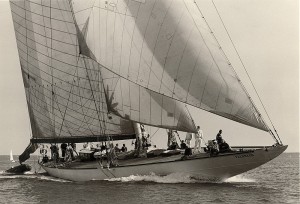
The sixth J-Class yacht to be built, and the second built on British soil was Velsheda . She was the only J not built as a contender for the America’s Cup. Her owner, WL Stephenson, who previously owned White Heather II, the 23-Metre converted to rate as a J-Class in 1930, had Velsheda built in steel in 1933 at the Camper & Nicholson yard. Velsheda was a great success. In 1935 she was significantly altered, her bow was snubbed around the waterline and her stern improved. The following season she won the King’s Cup at Cowes Week.
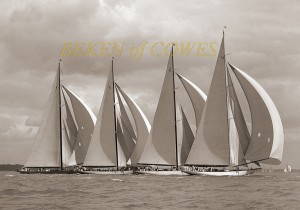
In 1934, Sopwith challenged for the America’s Cup. His challenger was Endeavour . She was Charles Nicholson’s third J-Class design and he said of her “She will have quite a normal hull… because I have thought it right to suppress possible experimental form, which would be most interesting to try out, but which I have to leave to American designers.” He did, however, produce the most beautiful J-Class and her rig was innovative.
Sopwith experimented with new running backstay strain gauges, which controlled the trim of the mast and used electronic windspeed and direction indicators. It has since been suggested that part of the reason for her failure in the Cup was due to all the gadgets on board. She was matched 83ft 3in on the waterline against Rainbow ’s 82ft. However, despite being thought to be the best challenger Britain has ever built, she did not win the Cup. Rainbow, which was considered the inferior boat, beat her by four races to two.

Rainbow was designed by W Starling Burgess and launched in 1934 from the Herreshoff yard where she was built in just 100 days. The J stepped a pear-shaped duralumin mast, designed to take the strain of the double-headed jib – first used on Whirlwind – and she was originally rigged with a Park Avenue boom. This was later removed because it was considered too heavy.
The UK Class was depressed with the death of King George V and scuttling of his yacht “Britannia” off the South of the Isle of Wight, in accordance with his will.
Of the American Js, Yankee was the only one to sail in British waters when she was bought by Gerald Lambert and crossed the Atlantic in 1935. She was scrapped in 1941. Enterprise and Whirlwind were both scrapped in America.
1937 saw the building of the last two J’s on both sides of the Atlantic. Both Ranger and Endeavour II took the waterline length to its extreme, measuring 87ft LWL . Ranger, the American boat, was built at Bath Ironworks in Maine and designed jointly by W Starling Burgess and Olin Stephens . It was a design combination, which produced the greatest J of the fleet – the ‘super J’ as she was later known. She was built, for the cost of the materials only, of flush riveted steel plating and soon after launching had an accident. The upper parts of her rod rigging which stayed her duralumin mast shook loose and her mast snapped “with a report like a cannon”.
Ranger’s success on the water was widespread. Of 37 starts she won 35. Owner-skipper Harold Vanderbilt described her as being “slower to turn and to pick up speed, but (she) held her way longer, and was perfectly balanced on the wind.” The challenger, Endeavour II, was designed by Nicholson again and built at the C&N yard. She too was steel, but flush-plated above and below the waterline. Sopwith towed her and Endeavour, plus an entourage of 100, to America where he worked on tuning her rig. Sadly, Ranger saw off the competition, easily winning four races, and dashing British hopes.
Although they became recognised the most beautiful yacht design in the world, only 10 J Class yachts were ever built – 6 in the USA and 4 in the UK. Most of these competed in trials for the America’s Cup, or competed in the Cup itself. Several existing large British yachts, ‘ Astra ’, ‘ Candida ’, ‘White Heather II’ and ‘Britannia’, the King’s yacht, were all converted to comply with the rule and raced alongside the J’s.
After the victory of Ranger over Endeavour II, Vanderbilt wondered whether the boat was so much faster than the competition that it might kill the class. History would show this was not the case as analysis of the Holm design shows that it would likely have been faster than Ranger.
1937 marked the end of an era – it was the last America’s Cup contest for 21 years and marked the end of Big Yacht racing. Shamrock V was sold to Mario Crespi, the Italian Senator and publisher, who converted her to a ketch rig and renamed her ‘Quadrifoglio’, with a literal translation giving her authentic name of ‘4 leaves’ in Italian. This was in accordance with an Italian law, which forbade foreign names.
Weetamoe was scrapped in this year, while at the end of the season Ranger was laid up, prior to being scrapped in 1941.
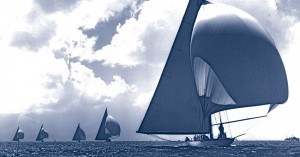
HANDLING THE J CLASS YACHTS IN THE 1930’s
The Skippers had to be experienced in racing and their skill on the race circuit became a matter of pride. These mighty craft had no engines and they had to be handled with great precision to get into and out of ports. Often their experience came from sailing all types of small craft, including fishing boats, during the winter months, when the J Class yachts were laid up. The permanent racing crew in the early days was probably around 16 men thou this may have been augmented to around 30 for racing. When not required for sail changes, spare crew were often moved to below decks.
With the incredible loads on the rigging and systems it was a constant concern that J Class masts could collapse in winds above a Force 3.
Sailing small boats in often inhospitable waters gave them the skills to manage their J Class yachts. The same is true today. Skippers have to deliver their yachts across Oceans, and compete around the race course, using their skills and all the technical advantages that are available today.
It is now clear that there was another J Class Yacht under development in 1937. Several years ago, drawings for a J-Class boat by Swedish naval architect Tore Holm were discovered by Fred Meyer, (Société Nautique de Genève – the Defender of the 32nd America’s Cup).
Now known as the Holm Project, this was to be a Swedish yacht with an innovative design. Many of the hull plates were made – and exist to this day. The project was put on hold prior to the outbreak of War in 1939 and was forgotten for more than 60 years. Endeavour and Endeavour II (K6) were laid up at Camper & Nicholson’s yard in Gosport, England.
Rainbow was scrapped. By the end of 1941, all the US yachts, which had been laid up were scrapped for their metal, with the last two being Yankee and Ranger. None survived. Yankee’s owner Gerard Lambert allegedly donated her scrap money from the yacht to Queen Mary to be used at her discretion in the London Hospital, in memory of the courtesies shown to Yankee by King George and the Queen herself.
Endeavour II was sold for scrap to Charles Kerridge Limited but her hulk remained until the late 1960s. Endeavour and Velsheda became houseboats in a mud berth on the River Hamble. This is where they stayed for more than 30 years, protected by the mud, which they had sunk into. Only Shamrock V was still sailing.
Endeavour II was broken up and scrapped in Southampton. Quadrifoglio (Shamrock V) had been hidden in Italy in a barn throughout the war years and following Crespi’s death in 1962 was sold to Piero Scanu, who saved her just two weeks before she was due to be broken up in Genoa.
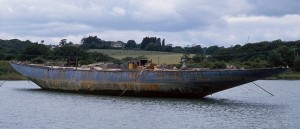
During the 1970s Endeavour’s hulk was sold for £10 and restoration was started.
Quadrifoglio (Shamrock V) arrived from Italy and was refitted at Camper & Nicholson’s yard where she had been built, supervised by Paolo Scanu the naval architect, and son of the owner.
The large holes in Endeavour’s hull were plugged and she was towed to the old seaplane base at Calshot Spit on the Solent to start restoration.
Terry Brabant rescued Velsheda from her Hamble mud berth and gave her enough of a refit to get her chartering and, occasionally, racing again in events like the annual Round the Island Race, hosted by the Island Sailing Club in Cowes. Despite being in rather poor condition she still acquitted herself well and looked magnificent from a distance. Swiss plans to restore her came to nought and the old racing yacht was eventually laid up afloat in Gosport. Elizabeth Meyer took on the challenge to continue with the rebuild of Endeavour at Calshot.
Quadrifoglio (Shamrock V) was purchased in 1986 by the Thomas Lipton Company, and given back her original name of Shamrock V, when she became the property of the Newport Museum of Yachting. Endeavour was towed from Calshot, to Cowes on the Isle of Wight to have her fittings and rigging fitted. She was then taken on a barge to the Royal Huisman Shipyard in Holland to continue and complete the rebuild.
Endeavour was relaunched in Holland. Endeavour and Shamrock V match raced each other over the Old America’s Cup course in Newport, Rhode Island in August.
Velsheda was purchased from a bankrupt C&N boatyard and brought to Southampton Yacht Services to start her rebuild. She was relaunched in 1998 and started her programme of racing and cruising around the World.
Velsheda, Shamrock V and Endeavour raced against each other in Antigua Classic Week.
The Owners met in England and formed the J Class Association to protect the interests of the Class, present and future. Class Rules were established for the construction of Replica Rebuilds from original plans. Shamrock V came out of a major refit at Pendennis in Falmouth under the supervision of the Dykstra office.

The first J Class Regatta is held in Christchurch Bay on England’s south coast over three days, followed by the Jubilee Regatta in Cowes.
Ranger replica was commissioned and construction started at Danish Yacht Shipyard.
Ranger was launched and started her racing programme.
Replicas of Endeavour II (Hanuman) and Ranger (Lionheart) are commissioned.
Replicas of Rainbow and Paine design (JH7) are commissioned.
Hanuman, replica of Endeavor II launched.
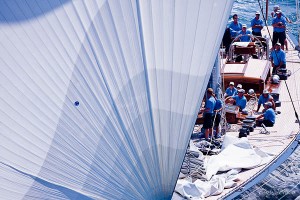
Lionheart launched.
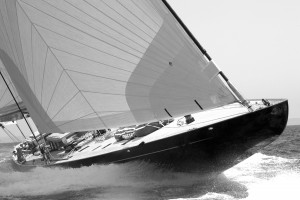
Rainbow launched. Cheveyo commissioned from Sparkman & Stephens / Spirit Yachts.

Information courtesy of the J Class Association
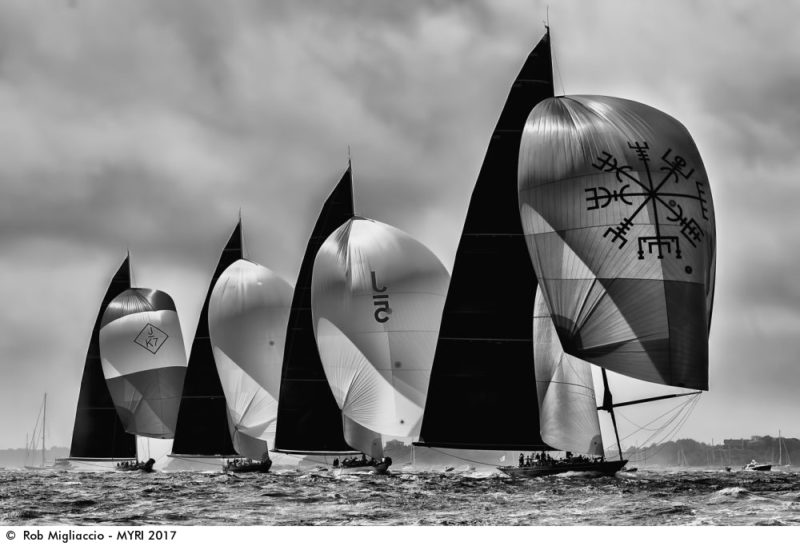
Svea, Velsheda and Topaz at the St Barths Bucket, 2018.
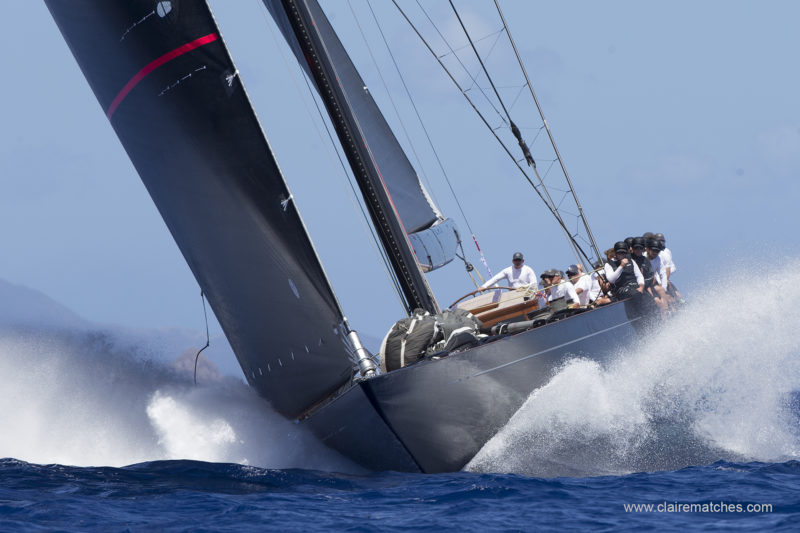
SHARE THIS:
- Yachts for Sale

Recently updated...

Write an Article
Covering news on classic yachting worldwide is a tall ask and with your input Classic Yacht Info can expose stories from your own back yard.
We are keen to hear about everything from local regattas and classic events to a local restoration or yachting adventure. Pictures are welcome and ideal for making the article more engaging.
With a site that has been created with the assistance of an international group of classic yacht enthusiasts we value your input and with your help we strive to make CYI more up-to-date and more informative than ever.
Please register and get in touch if you would like to contribute.

choose your language:
We’re passionate about Classic Yachts here at CYI, and we welcome submissions from all over the globe!
Captain, rigger, sail-maker or chef – if you’d like to write for CYI just let us know!
Email [email protected] to be set up as a Contributor, and share your Classic thoughts with the world.
ClassicYachtInfo.com has the largest database of classic yachts on the internet.
We’re continually working to keep it accurate and up-to-date, and we greatly appreciate contributions of any type. If you spot an error, or you have some information on a yacht and would like to contribute, please jump on in!
Don’t be shy…. Breeze on!
- Sell Your Yacht

Published on June 26th, 2017 | by Editor
Return of the J Class Yacht
Published on June 26th, 2017 by Editor -->
J Class yachts , which reigned supreme in the 1930s, are making a thrilling comeback, with restorations, new builds and the biggest fleet the class had ever seen at the America’s Cup J Class Regatta . Why wasn’t the event broadcast, people asked. One theory was the fear of higher viewership than the actual America’s Cup.
In this report by Matthew Sheahan , he charts a return to glory for the class.
Only 10 were ever built from just 20 designs and their reign lasted less than a decade. In their day, J Class yachts were the most technically advanced and universally admired yachts in the world. They drew royalty and captains of industry aboard, while regularly pulling big crowds of spectators to vantage points ashore. But the death of a sovereign, who regularly raced one, and the threat of a world war saw them disappear as fast as they had arrived.
Of the 10 that were raced between 1930 and 1937, six were built in America and four in the UK. Three of the British boats survived, but only just, while all the American ones were scrapped.

Conceived in 1930 as a more affordable alternative to the previous generation of expensive, one-off America’s Cup yachts, now, more than 85 years later, J Class is about to hit a new high. In 2017, seven J Class owners raced their boats in Bermuda – the biggest fleet the class had ever seen ( see photos ).
Of the original examples that still existed, Endeavour was the first to be fully restored back in the 1980s. Velsheda and Shamrock V followed. Since then, all three have been newsworthy sights at some of the most famous yachting venues around the world. From there, fascination with the Js continued, but with no original boats to restore, people started building replicas.
The first was the American yacht Ranger. “When we launched her in 2003 she was the first new-build J Class yacht for 66 years,” says owner John Williams. “I have had a number of large yachts over the years, but owning a J Class is like owning an F1 car, you simply can’t go back.”
The launch of Ranger, combined with Williams’ success on the water, inspired the construction of others, including Hanuman, the modern interpretation of aviation pioneer and yachtsman Thomas Sopwith’s 1936 J Class, Endeavour II.
Indeed, it was the competition between Endeavour II and the original Ranger that rekindled interest in the last J Class battle for the America’s Cup in 1937, when Harold Vanderbilt wiped the floor with Endeavour II in a match that brought down the curtain on prewar J Class activity and the class itself.
Some owners are now even building yachts from original 1930s lines plans that were never actually constructed. Lionheart was the first– one of seven rejected Ranger models from 1936. Svea, which launched earlier in 2017 ( see photos ), is the latest example – based on an original Tore Holm design from 1937, brings the total in the J Class fleet to nine.
Over three decades, J Class fever has taken a hold at a price tag of around $16.5m apiece. They are expensive boats to run too, costing around $1.3m to $2.5m per year for a racing J. The most competitive might even have new sails for each regatta, so with a single genoa priced at around $127,000, campaigning these boats is not for those looking to compete on a modest budget. And herein lies part of the appeal.
A J Class is not simply a type of yacht – it’s a phenomenon and has always attracted the world’s wealthiest individuals. In addition to Sopwith, Vanderbilt, George V and tea magnate Thomas Lipton were among the famous owners on both sides of the Atlantic. As well as satisfying a personal zest for yacht racing, the boats drew attention that often helped develop their global businesses.
Today, many current owners are equally accomplished, whether as captains of industry, technology or the internet, but in contrast to their forebears many prefer anonymity and are discreet about their professional backgrounds. That said, they are just as besotted with what are described as the most beautiful yachts in the world. Such is the legacy of the J that many see their ownership as simply custodial, even if the boats are replicas.
Back in 1984, American writer and businesswoman Elizabeth Meyer kick started the reincarnation of the J Class when she bought the derelict and barely floating hulk of Endeavour. One of the most famous of all the Js, Endeavour is still widely considered to have been Britain’s best chance of winning the America’s Cup in over 160 years. A full restoration programme saw the yacht back afloat in 1989.
“The size and beauty of these boats is a huge draw. It is hard to make a boat look as beautiful as a J does – there is some magic to it,” says Dutch businessman Ronald de Waal. As the owner of Velsheda, he admits to being hooked on the class. “Their history is also an attraction. They all have a big provenance.”
De Waal’s involvement started almost by accident but quickly led to Velsheda’s full restoration from a bare hull and deck. “I had bought a 40m yacht that caught fire during trials, which led to me looking for another boat,” he explains. “Yacht designer Gerard Dykstra found out there was a J Class hull that had been confiscated after the boatyard restoring it ran into financial difficulties. I paid off the shipyard and the bank, bought the hull and set about restoring the boat, and in 1997, she was launched.”
De Waal is the longest-serving J Class owner and remains very active on the racing scene. His enthusiasm and support, along with Dykstra’s design expertise, have been instrumental in the development of the current fleet. Where Meyer was the catalyst, De Waal and Dykstra have created solid foundations for the class. “To own a boat like Velsheda is to own something that is irreplaceable,” says De Waal. “It’s not just about the money, it’s the history and the almost spiritual feeling about the boat and what she stands for. It reminds me of life and living, it’s that strong a connection.”
Dykstra and his design team have been involved in no fewer than six different Js, with another on the drawing board, and remain closely involved with the practical day-to-day aspects of running a J campaign. “When you step aboard a J, you are not just a sailor but a part of yachting history,” says Dykstra. “The sailing is impressive, but it’s impossible not to be affected by the sense of heritage and the part these boats have played. They drew huge crowds in their day, and today’s spectators are equally fascinated.”
While the J Class continues to epitomise all that was grand, elegant and competitive about yacht racing in the 1930s, the reality is that these boats were, and remain, challenging brutes to handle. Not surprisingly, their immense power and complexity attract some of the world’s top professional sailors.
Jeroen de Vos at the Dykstra design office is one of several staff who sail regularly on Js. “Of the 30 or so crew aboard, more than 20 need to be highly experienced sailors,” he says. “You have to work flawlessly as a team because the boats are so powerful that the slightest mistake can result in a serious situation. The level of competition is also extremely high.”
Following the racing in Bermuda, the aim of the fleet is now the 2017 J Class World Championship on August 21-26 in Newport, RI
Sharing the credit for the new wave of Js is designer Andre Hoek who has created five of the modern Js. His work has concentrated on yachts like Lionheart and Topaz, modern builds from original lines.
“The move to aluminum as a construction material has been a big step for the class and one of the key factors in their current appeal,” he says. “Originally the boats were stripped-out racing machines built from steel. Today, owners want full interiors with creature comforts and systems that allow them to cruise the boats as well. A lighter aluminium build means they can have these interiors and still float to their original lines.”
Another key factor has been the clever handicapping system that ensures equitable racing at all the events. The handicap system was originally developed by Dykstra in conjunction with technical experts at the Wolfson Unit at Southampton University, which required detailed performance analysis. Andre Hoek’s team has also spent time assessing the current and future performances of the Js, but for subtly different reasons.
“We conducted a huge amount of research with velocity prediction programs to assess the various performances of the boats, both those that had been built and those that were just designs,” says Hoek. “The result is we now know more about why certain hulls work and others don’t. We can also see which of the original designers were working along the right lines.”
The willingness and enthusiasm of owners to take their elegant yachts to the mid-Atlantic island of Bermuda in June 2017 is testament to both the continued pull of the America’s Cup and to the historical significance of the J Class.
“It’s rare for a venue to host more than a few boats, but the Hamilton Princess hotel in the centre of the town provided berthing for all the Js,” says J Class Association secretary and event organiser Louise Morton. “This created an incredible spectacle, right at the heart of the event.”
J Class yachts could not be more different from the modern, lightweight, high-speed, hydrofoiling catamarans that are the current America’s Cup boats.
A J Class has a single 41m hull, a lead keel and over 900sq m of sail. She requires around 30 crew, weighs around 150 tonnes and has a typical maximum speed of 12 knots (14mph). A modern America’s Cup catamaran is 15m long, has two hulls, flies above the water on hydrofoils at speeds approaching 52 knots (60mph) and is powered by an aeroplane-style wing sail. The boat is sailed by just six crew and weighs only 1,320kg.
On the face of it there is no comparison, yet they share the same DNA. Just as current foiling catamarans are defining new limits, the Js of the 1930s represented the leading edge of yacht design and construction, their size and loads pushing at the limits of what was technically possible.
But it wasn’t just the boats and their towering 50m masts and colossal sails that were breaking new ground; systems and technologies developed elsewhere on the boat were also helping to shape the modern era of both racing and cruising yachts. A good example is the development of electronic sailing instrumentation for information on wind strength and direction. First used on Sopwith’s J Class Endeavour II, such instrumentation soon became commonplace.
Even to this day, such technical developments have continued. “In the early 1990s, the winches on these boats were manually powered by the crews winding pedestal grinders,” explains Dykstra. “Now those grinders have been replaced with hydraulically powered winches that allow crews to handle the boats more efficiently. It has changed the game and led to more advanced systems and new sailing techniques.”
So while the enthusiasm for this classic yacht may appear to be driven by nostalgia, the boats are continuing to do exactly what they were originally designed to do – push the boundaries and create the ultimate racing machine. Sometimes history repeats itself in unexpected ways.

Tags: America's Cup , America's Cup J Class Regatta , J Class , Matthew Sheahan
Related Posts
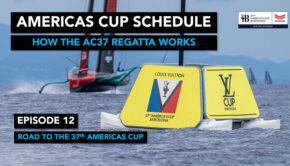
Ep12: Road to the 37th America’s Cup →

First glimpse of the AC75 racing →
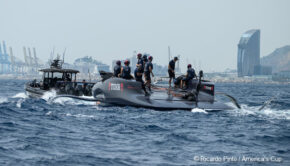

America’s Cup: Alinghi dismasted again →
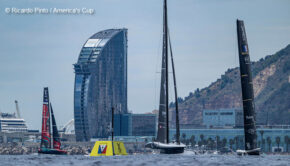
America’s Cup: Are teams ready to show? →
© 2024 Scuttlebutt Sailing News. Inbox Communications, Inc. All Rights Reserved. made by VSSL Agency .
- Privacy Statement
- Advertise With Us
Get Your Sailing News Fix!
Your download by email.
- Your Name...
- Your Email... *
- Name This field is for validation purposes and should be left unchanged.


The global authority in superyachting
- NEWSLETTERS
- Yachts Home
- The Superyacht Directory
- Yacht Reports
- Brokerage News
- The largest yachts in the world
- The Register
- Yacht Advice
- Yacht Design
- 12m to 24m yachts
- Monaco Yacht Show
- Builder Directory
- Designer Directory
- Interior Design Directory
- Naval Architect Directory
- Yachts for sale home
- Motor yachts
- Sailing yachts
- Explorer yachts
- Classic yachts
- Sale Broker Directory
- Charter Home
- Yachts for Charter
- Charter Destinations
- Charter Broker Directory
- Destinations Home
- Mediterranean
- South Pacific
- Rest of the World
- Boat Life Home
- Owners' Experiences
- Conservation and Philanthropy
- Interiors Suppliers
- Owners' Club
- Captains' Club
- BOAT Showcase
- Boat Presents
- Events Home
- World Superyacht Awards
- Superyacht Design Festival
- Design and Innovation Awards
- Young Designer of the Year Award
- Artistry and Craft Awards
- Explorer Yachts Summit
- Ocean Talks
- The Ocean Awards
- BOAT Connect
- Between the bays
- Golf Invitational
- BOATPro Home
- Superyacht Insight
- Global Order Book
- Premium Content
- Product Features
- Testimonials
- Pricing Plan
- Tenders & Equipment
The new J Class sailing yacht Lionheart
Lionheart was the third new J Class to be launched since Harold S Vanderbilt's successful America's Cup Defender, Ranger , took to the water in 1937. In 2003, a replica of Vanderbilt's Super J Ranger left the Danish Yacht boat yard and immediately began racing, followed six years later by the J Class replica of Endeavour II , renamed Hanuman , leaving the Royal Huisman Shipyard and competing successfully against Ranger just four months after launching. With the launch of the Hoek Design_ Lionheart_ from Claasen Jachtbouw the stakes have been raised again.
The meeting between the replicas of Ranger and Endeavour II was significant when the duo met in 1930s, Ra nger _was victorious, but the more recent _Endeavour II-r eplica, Ha numan, triumphed on the water 90 years later.
For Andre Hoek, a detailed research program focused on testing the various, original J Class designs revealed that Lionheart was one of the best set of designs available for an all-round, high-performance J.
When an existing client came to us for a third yacht, his main interest was a new J Class yacht,' says Hoek. 'He asked us what we would do if we were to build a new J and that led to a proposal to first do a dedicated research project to determine what would possibly be the best performing J Class yacht.
'We proposed to analyse the theoretical performance of all existing J Class lines and to develop a dedicated Velocity Prediction Program specifically geared to J Class hulls with long keels,' the marine architect explains, 'as the existing VPP software is all for round-bilged hulls with fin keels and spade rudders, which are totally different hydrodynamically to a long keel hull with a rudder that forms a flap on a long keel.'
The proposal was accepted and a new Velocity Prediction Program for typical J Class hulls was developed together with Peter van Oossanen (of wing keel and FDHF fame).
Tank test data of a 20 foot long model of the J Class _Rainbow _was used to calibrate the mathematical formula of the VPP program. With this new software, initially all possible Super Js (with a maximum waterline length of 26.51m) were analysed for performance both on line honours and handicap.
The five best-performing hulls from this research were then analysed using computational fluid dynamics software (CFD). The CFD analysis confirmed the VPP findings and the search was narrowed to three hull designs:
One of the eight tank-tested designs commissioned by Vanderbilt from W Starling Burgess and Olin Stephens for the Ranger 77-F project;
Svea , designed by Sweden's Tore Holm in 1938 but never built; and A Frank C Paine design that didn't progress beyond the drawing board.'Of the final three, Lionheart showed the best overall performance,' Hoek reveals. 'The Paine-designed Atlantis is a very good light wind and downwind boat and Svea is the best upwind boat.'
Furthermore, the research proves that the_ Lionheart_ design is faster than the lines chosen for the original Ranger a choice that was not due to flaws in the combined wisdom of Vanderbilt, Burgess and Stephens, but purely that tank testing with models of just under a metre in length is now known to supply inconclusive and misleading data.
Once the optimum design podium was full, the client purchased the intellectual property rights for the Burgess/Stephens Ranger 77-F designs from Sparkman and Stephens and optimisation began on the_ Lionheart_ hull, rig and sail plan. The process started with recreating the 1937 lines to ensure that both port and starboard matched a common error in early, hand-drawn, pre-digital designs.
Continuing research soon showed that the designs with the buoyancy further forward were more effective; wind tunnel testing produced the sail plan geometry, and rudder angle calculations with the new VPP dictated the mast position.
The next phase in the design process was hull strength and construction. While the original J Class yachts were built in steel, the J Class Association (JCA) allows the modern, replica yachts to use aluminium a farsighted decision by the JCA, but one that raises issues of longitudinal stiffness in yachts possessing the enormous overhangs synonymous with the classic J Class profile.
To prevent the characteristic hogging, sagging and alarmingly slack standing rigging associated with an elastic, aluminium hull, Hoek and his team used a 3D finite element model (FEM) to explore load levels throughout the yacht, resulting in an exquisite, internal lattice of aluminium supports to keep Lionheart stiff, and hull panels of multiple thicknesses dependant on specific load stress areas.
While the overall hull design remained faithful to the original, 1930s J Class remit, one aspect of the replica hulls had to change. 'We are allowed to raise the freeboard by 10cm and make a bulwark of an extra 10cm above the level of the deck,' confirms Hoek. 'These are the only two changes you are allowed to make to the original lines.'
The reason the JCA introduced the rule change is simple: 'It has everything to do with the fact that the boats were never built to be equipped with vast interiors, generators, powered winches, galleys and electronics,' Hoek explains. 'There were hardly any interiors in these boats and they were purely built for racing.'
However, J Class purists who fear that the sanctity of the original class rule has been compromised with modern tampering should realise that the truth is somewhat different.
'Most people think that a J Class has an extremely low freeboard with long overhangs,' continues Hoek. 'Especially when you look at the original, surviving boats Ve lsheda, Shamrock V _and _Endeavour.'
In reality, the modern equipment on Velsheda and _Endeavour _has sunk both yachts by around 30cm below their 1930s waterline.
'None of the surviving Js fit the original Universal Rule now,' he adds.
The Universal Rule ensured that waterline length was no longer than 87 feet (26.51m). 'In some of them, the waterline length is now about 95 feet as they are so much lower in the water,' states Hoek.
Historically, the 26.51m waterline achieved by the Super J yachts was a fundamental advantage an area researched heavily by Vanderbilt.
'In 1936, they did a test with Rainbow and ballasted her down to precisely 26.51m,' recalls Hoek. Sinking the yacht below her natural 24.99m waterline delivered immediate results.
'She was faster than she was before due to the improved righting moment, but still did well in light airs,' he adds. 'The conclusion that a Rainbow -type boat at 26.51m waterline length would be high performance led to all the subsequent Ranger designs.'
The implications of this issue are twofold in terms of performance and aesthetics, for although modern photographs of the surviving yachts suggest that reduced freeboard is more in keeping with tradition, the replica Js with their stretched overall length in the overhangs to compensate for the increased freeboard, share an identical design DNA.
'So, technically, the freeboard of the new boats is higher,' explains Hoek, 'but they are actually closer to the original.'
Lionheart's immaculate hull has been built at the Bloemsma yard, a key player in the current J Class revival, which has also been responsible for the hulls of Atlantis and Rainbow . Lionheart's fitting out was done at Claasen Jachtbouw with a team of 20 craftsmen and specialist contractors working with extraordinary co-ordination in the yacht's slender hull.
Deeper into the boat at the turn of the bilge in an area that charter guests are unlikely to visit the engine room is a masterpiece of space management. Despite the sheer volume of engineering squeezed into such a confined space, it is possible to stand upright and move around without skinning elbows or slipping discs.
And while Claasen Jachtbouw is famous for its exquisite joinery work and attention to detail, technical installations are to very high quality levels as well. MCM from Newport, USA, acted as the owner's representative a team of specialists that have added considerable experience to the build team. Their vast technical and big boat racing experience has also contributed to the end result on board.
For Victor Weerens, the yacht's project manager at Claasen Jachtbouw, Lionheart has been an exceptional experience.
'It has been a great project for us with many challenges,' he admits. 'But the team here and our sub-contractors have met all the demands of building a modern J.'
After launching she was taken up river to Zaandam for the stepping of the clear-coat carbon mast and boom from Hall Spars with Future Fibres PBO rigging.
Bugsy Gedlek; Claasen Jachtbuow; Freddie Bloemsma Aluminiumbuow; and courtesy of Hoek Design
Sign up to BOAT Briefing email
Latest news, brokerage headlines and yacht exclusives, every weekday
By signing up for BOAT newsletters, you agree to our Terms of Use and our Privacy Policy .
More about this yacht
More stories, most popular, from our partners, sponsored listings.
J-Class Rainbow – 131′ -2012
Download brochure.
Please complete the below details in order to start the brochure download:
I request to be contacted by: *
Built by the Dutch Masters at Holland Jachtbouw in 2012, RAINBOW is quite simply, the best of her breed. One of the most recently launched J-Class reproductions, Dykstra Naval Architects developed RAINBOW from the original plans of this 1937 America’s Cup winner and smoothed her lines to modern hydrodynamic standards, optimized to the new J-Class Rule. Her engineering and construction created a modern classic, built with “cutting edge” technology, engineering and materials, from her “hybrid” diesel/electric drive and electrical system, to her high modulus spar, carbon rigging and electro-hydraulic sail and boat handling systems.
RAINBOW is a true “dual purpose” yacht, serving equally successfully as a “silver service” charter yacht for up to eight guests, or as a grand prix racing yacht of the highest caliber. In cruising mode, the yacht has all attributes for easy operation; hydraulic sail handling, winches, thrusters, and a simple sail-plan. Her entertaining cockpit dresses for comfortable entertaining, lounging and dining, and her interior offers all amenities for gracious living aboard. For racing, pulpits & lifelines are removed as all deck areas are stripped and streamlined for the efficiencies required at the absolute pinnacle of yacht racing. RAINBOW’s record speaks for itself on both counts.
Specifications
J-Class Yachts: Rainbow Launched: Press Release
| Project Launched: |
| based on the 1934 America's Cup Defender |
Holland Jachtbouw has launched the J-class yacht Rainbow at its yard in the Netherlands. Based upon the lines of the original Americas Cup winner in 1934, this spectacular 40-metre J features a high-end superyacht interior and a unique hybrid propulsion and power system inside a racing boat hull, all topped off by a grand prix racing deck and rig. Rainbow is currently being stepped and sea trials will commence in March as she gears up to complete in this summer’s regattas, including the J-class races in England.
For her launch Rainbow was brought outside the ultra-modern main construction hall at Holland Jachtbouw, wheeled onto a barge and lifted by two cranes into the water. This sophisticated operation took full advantage of the yards rare capacity to launch vessels with a draught of five meters (Holland Jachtbouw can actually accommodate yachts of up to 5.5 meters draft and 65 meters in length).
It is such a thrill to be able to fully appreciate a design that was last seen in the open almost eighty years ago, says the yards co-director Tako van Ineveld. This new Rainbow took us over two years to build while her predecessor was completed in just one hundred days. This does not mean we are slower. It is a reflection of the incredible degree of sophistication that is now contained within these timeless lines. The original Rainbow was an empty boat with a deck of sailing gear and a powerful aluminum rig. This Rainbow is a different proposition altogether.
The projects naval architects were Dykstra & Partners, and this office also partnered with deVosdeVries design on the interior. The original Rainbow was drawn by William Starling Burgess in the early 1930s and the vessel was scrapped in 1940. This design has now been incorporated into an all-aluminum yacht that meets the J-class Association maximum performance rules.
All modern functional requirements have been integrated with full respect for Rainbow' s heritage, while the decks have been kept as clean and flush as possible featuring only a mahogany doghouse and skylight. The latter offers a quite spectacular contrast with the superb jet black-colored hull and gold-leaf cove stripe. We believe that Rainbow is the most beautiful J on the water today, says Van Ineveld. But more importantly, she is built to win races!
Gerry Dijkstra and his team have utilized all their vast experience and the very latest computer modeling to optimize Rainbows performance via a lightweight construction with a high degree of overall stiffness. The rig includes a Southern Spars high-modulus carbon mast, boom and spinnaker pole, continuous carbon fiber rigging, North Sails 3Di racing sails and Lewmar high-speed hydraulic winches. All are entirely customized to Rainbow' s specific requirements and, like everything metallic on deck, anodized to create a light grey look.
All the new generation of Js need to have a fully functioning interior under JCA rules, and Rainbow' s owner has spared no expense when it comes to luxury accommodation and premium equipment, including full air conditioning. The original Rainbow did not have an engine room so there was obviously not a great deal of space to accommodate one within the lines plan. Holland Jachtbouws solution, developed in partnership with WhisperPower, has been to create an ingenious ‘hybrid propulsion’ and power system especially for this project.
As a result, Rainbow can be operated entirely on her Hy-Store Li-ion batteries, including sailing, navigation and hotel load. This also meets the owner’s request for silent periods onboard, without generators running, from 11 pm to 7 am. And that in turn promises much for those who enjoy cruising and, potentially, chartering Rainbow .
This hybrid solution replaces the conventional main engine and two generator configuration found on other Js, which have a larger engine room than the comparatively lighter Rainbow (170 tonnes). The main engine replaces the second generator, while the remaining generator is a variable speed electric unit. The main engine generator can also act as an electric motor that can also run the propeller. This solution is smaller in size and saves on fuel. The batteries can also be charged while sailing without losing more than 1.5 knots of speed.
Other key overall benefits of this innovative propulsion solution include a dramatic reduction of the ecological footprint, a 30 percent reduction in the fuel required to generate the hotel load, and a similar reduction in the maintenance costs for the power plant in hotel load. Redundancy is built-in with five power sources available: The hybrid battery, the variable speed generator, the variable speed engine generator, the shaft generator (when sailing) and shore power (when available). There is also a substantial reduction in audible noise levels both inside the yacht and out.
In terms of styling, Rainbow' s interior features raised and fielded mahogany paneling with art deco details. The owner’s stateroom is aft and there are two ensuite twin guest cabins, each with a Pullman berth. In addition to offering accommodation to up to eight guests, Rainbow will have a permanent crew of seven led by Captain Nick Haley who has previously skippered two other members of the Holland Jachtbouw fleet, namely Windrose of Amsterdam and Athos .
This April a team of race professionals will join the permanent crew for the first time to embark on seven days of extensive training in the North Sea. All will look very impressive thanks to a sponsorship agreement with Pelle Petterson. This renowned competition yachtsman has taken a keen interest in the Rainbow project and offered to supply his trademark Pelle P technical sailing clothes. During the J-class regattas in Falmouth and Cowes, Rainbow will be accompanied by a support vessel to accommodate the larger crew at night.
Rainbow also has a full schedule of engagements to compete in the other major regattas of 2012. The general public will be able to admire her at the Monaco show where Rainbow will be on display close to the Holland Jachtbouw stand.
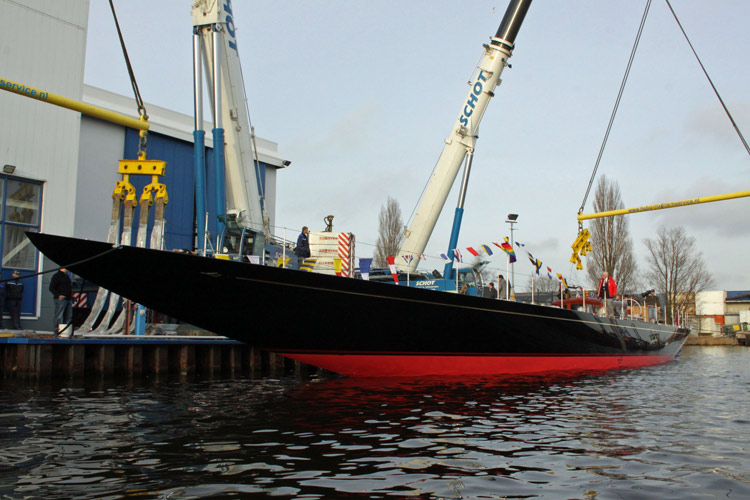
Links of Interest: New J-Class Rainbow is Under Construction (Press Release October 2009) New Rainbow Project Announced (Press Release) New Yankee Project Announced (Press Release)
Rainbow website: rainbow-jh2.com
Holland Jachtbouw website: www.hollandjachtbouw.nl
Dykstra and Partners website: www.gdnp.nl
Additional Links of Interest: CupInfo's Story of the J-Class yachts
CupInfo Home
In total nine J Class yachts are currently active, including three original surviving Js - Velsheda, Shamrock and Endeavour - and six replicas that have been built since 2003; Ranger, Rainbow, Hanuman, Lionheart, Topaz and Svea.

Endeavour, JK4

Velsheda, JK7

Rainbow, JKZ1

Shamrock V, JK3

Hanuman JK6

Lionheart, JH1

This site uses cookies to enhance your experience. By continuing to browse the site, you consent to the use of cookies. View our Privacy Policy for more information.

- Visit Our Blog about Russia to know more about Russian sights, history
- Check out our Russian cities and regions guides
- Follow us on Twitter and Facebook to better understand Russia
- Info about getting Russian visa , the main airports , how to rent an apartment
- Our Expert answers your questions about Russia, some tips about sending flowers

Russian regions
- Adygeya republic
- Astrakhan oblast
- Kalmykia republic
- Krasnodar krai
- Rostov oblast
- Volgograd oblast
- Map of Russia
- All cities and regions
- Blog about Russia
- News from Russia
- How to get a visa
- Flights to Russia
- Russian hotels
- Renting apartments
- Russian currency
- FIFA World Cup 2018
- Submit an article
- Flowers to Russia
- Ask our Expert
Astrakhan Oblast, Russia
The capital city of Astrakhan oblast: Astrakhan .
Astrakhan Oblast - Overview
Astrakhan Oblast is a federal subject of Russia, part of the Southern Federal District, situated in the Caspian Lowlands where the Volga River flows into the Caspian Sea. Astrakhan is the capital city of the region.
The population of Astrakhan Oblast is about 989,400 (2022), the area - 49,024 sq. km.
Astrakhan oblast flag
Astrakhan oblast coat of arms.
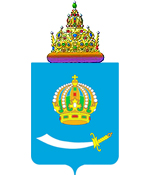
Astrakhan oblast map, Russia
Astrakhan oblast latest news and posts from our blog:.
4 March, 2020 / Astrakhan - one of the oldest cities in southern Russia .
18 May, 2019 / Colorful summer sunset in the Volga River delta .
4 April, 2019 / Cities of Russia at Night - the Views from Space .
11 May, 2017 / Astrakhan Kremlin after the Restoration .
13 December, 2016 / Astrakhan - the view from above .
More posts..
History of Astrakhan Oblast
In ancient times, the territory of the Astrakhan region was crossed by trade routes of the Persians and the Arabs. In the 8th-10th centuries, the territory belonged to the Khazar Khanate. There is a hypothesis that Itil, the capital of the Khazar Khanate, was located on this territory. It was destroyed by Prince Svyatoslav in 965.
Later, Polovtsy settled on this land. In the first half of the 13th century, the Mongol-Tatars came to the area. After them, Tatars of the Astrakhan Khanate and Kazakhs became the main population of the region.
In 1556, during the reign of Ivan the Terrible, the Astrakhan Khanate was annexed to the Russian state and ceased to exist. Astrakhan krai became the southeastern military outpost of Russia. In particular, in 1569, the Turks unsuccessfully besieged the fortress of Astrakhan.
In the 17th century, trade, fishing and salt industries developed in the region. In the middle of the 17th century, the uprising of Stepan Razin took place on the territory of Astrakhan region. In 1722, near the mouth of the Kutum River, a shipyard called the Astrakhan Admiralty was built. In the 1730s-1740s, the processing of silk and cotton began here.
Astrakhan Oblast was created in 1943. The region gained its current borders in 1957.
Steppe landscapes of Astrakhan Oblast
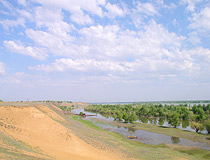
Astrakhan Oblast scenery
Author: Dvornikov Mikhail
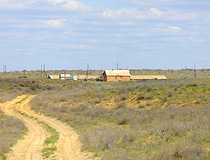
Steppe road in the Astrakhan region
Astrakhan Oblast - Features
Astrakhan Oblast is located in the south-east of the East European Plain within the Caspian Lowlands. It is an area of deserts and semi-deserts. Astrakhan oblast borders on the Volgograd region in the north, the Republic of Kalmykia in the west and Kazakhstan in the east.
It is located on the border between Europe and Asia, the Volga River gives access to five seas. The main cities of the region are Astrakhan (518,700), Akhtubinsk (35,500), Znamensk (25,700), Harabali (17,100).
The climate of Astrakhan Oblast is continental, dry. Winters are with little snow, frequent thaws and unstable snow cover; summers are hot. January is the coldest month, the average temperature is minus 10-20 degrees Celsius. July is the hottest month - the average temperature is plus 35-45 degrees Celsius.
According to the 2010 census, the ethnic composition of the local population is the following: Russians (67.6%), Kazakhs (16.3%) and Tatars (6.6%). Orthodox Christianity is the main religion. However, Muslims also make up a significant group of the population (more than 20%). Historically, this province was a place where Kazakhs and Tatars settled. The largest Kazakh community in Russia lives in the Astrakhan region.
Astrakhan Oblast views

Paved road in Astrakhan Oblast
Author: V.Kildushov

Camels in Astrakhan Oblast
Author: Viktor Grigoriev
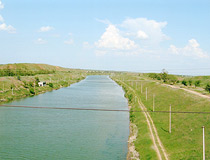
The Volga-Don Shipping Canal in Astrakhan Oblast
Author: Kudanov Pavel
Astrakhan Oblast - Economy
Natural resources of the region include natural gas, oil, salt, gypsum.
The industrial complex of Astrakhan, the economic center of the region, includes shipbuilding, pulp and paper industry, fish processing industry. The leading industries are fuel industry, mechanical engineering, power engineering, food industry. Astrakhan gas condensate field, the largest in the European part of Russia, is located in the area. Astrakhan Gas Processing Plant produces gas for cars, diesel and boiler fuel.
Agricultural lands make up more than 3.4 million hectares - the cultivation of tomatoes, peppers, aubergines, courgettes, cucumbers, carrots, beets, onions, cabbage, watermelons. Rice is traditionally grown along the Volga. The leading branch of livestock is sheep breeding.
The region stretches for over 400 km in the form of a narrow stripe on both sides of the Volga-Akhtubinsk flood-lands. Flooded for a long time, the territory of the delta serves as spawning-ground for such fish as sturgeon, stellate sturgeon, white sturgeon and others.
Astrakhan oblast of Russia photos
Pictures of astrakhan oblast.

Lenin Monument in Astrakhan Oblast
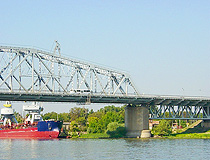
Bridge in Astrakhan Oblast
Author: Anatoliy Martyshkin

Church in Astrakhan Oblast
Limanskiy Khurul - the only active Buddhist temple in Astrakhan Oblast
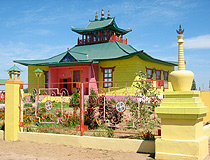
Limanskiy Khurul in Astrakhan Oblast
Author: Moskaluk Vitaly
The comments of our visitors
- Currently 2.95/5
Rating: 3.0 /5 (199 votes cast)

Belarus interested in construction projects in Russia’s Astrakhan Oblast


IMAGES
COMMENTS
The J Class Association was founded in 2000 to protect the interests of the Class, present and future, and organises an annual calendar of racing for these magnificent yachts. 2024 Calendar. 19-22 June.
With the exception of Velsheda, all the original Js were built for the purpose of America's Cup racing. From 1929 to 1937, 20 J Class yachts were designed. Ten of these were built, and six raced ...
J Class yachts Velsheda, Topaz and Svea downwind legs. The J Class is one of several classes deriving from the Universal Rule for racing boats. The rule was established in 1903 and rates double-masted racers (classes A through H) and single-masted racers (classes I through S). From 1914 to 1937, the rule was used to determine eligibility for ...
Lipton commissioned Charles Nicholson to design his contender. Shamrock V became the first J Class yacht. She was designed by Nicholson and built at the family yard in 1930, and before she crossed the Atlantic to attend the Cup she had notched up more than 700 sea miles (1,296km), won 15 out of the 22 races she had entered and had been tweaked and tested to a high degree.
The J Class - so named because it was the letter allocated to its particular size by the Universal Rule to which the yachts were built (K and M Class yachts were, for example, shorter on the ...
The J-Class website points out that there are 10 unbuilt J designs from the 1930's, so the possibilities for more J-Class yachts are intriguing. Yachting World reported in May, 2003, that construction was underway on a yacht replicating the famous G.L Watson design Britannia. Photos showed a nearly completed hull at Solombala Shipyard, in ...
J Class yacht Velsheda sailplan. LOA: 39.25m/128ft 9in · LWL: 27.8m/91ft 3in · Beam: 6.57m/21ft 7in · Disp: 180 tonnes. Original lines: Charles E Nicholson. Modified design: Dykstra Naval ...
In total nine J Class yachts are active now with six replicas having been built since 2003; Ranger, Rainbow, Hanuman, Lionheart, Topaz and Svea. The J Class Association (JCA) was founded to protect the interests of the Class, present and future. Among its responsibilities it monitors and agrees the veracity of designs to which new replica boats ...
Ranger is a 41.55 metre replica of the J Class yacht of the same name, which was built for the 1937 America's Cup by a syndicate led by railroad heir Harold Vanderbilt. Starling Burgess and Olin Stephens had been asked to produce eight sets of lines and the one selected as most suitable for the conditions expected off Newport, Rhode Island — design number 77C — was one of Burgess ...
The sixth J-Class yacht to be built, and the second built on British soil was Velsheda. She was the only J not built as a contender for the America's Cup. Her owner, WL Stephenson, who previously owned White Heather II, the 23-Metre converted to rate as a J-Class in 1930, had Velsheda built in steel in 1933 at the Camper & Nicholson yard.
Published on June 26th, 2017. J Class yachts, which reigned supreme in the 1930s, are making a thrilling comeback, with restorations, new builds and the biggest fleet the class had ever seen at ...
Endeavour is a J-class yacht built for the 1934 America's Cup by Camper and Nicholson in Gosport, England.She was built for Thomas Sopwith who used his aviation design expertise to ensure the yacht was the most advanced of its day with a steel hull and mast. [1] She was 130-foot (40 m) and launched in 1934 and won many races in her first season including against the J's Velsheda and Shamrock V.
Lionheart was the third new J Class to be launched since Harold S Vanderbilt's successful America's Cup Defender, Ranger, took to the water in 1937.In 2003, a replica of Vanderbilt's Super J Ranger left the Danish Yacht boat yard and immediately began racing, followed six years later by the J Class replica of Endeavour II, renamed Hanuman, leaving the Royal Huisman Shipyard and competing ...
The new Yankee, based on the 1930 Candidate for the Defense, will join the new J-Class Yacht Rainbow, based on the 1934 America's Cup Defender. Drawing: 2009 Dykstra & Partners. Yet another J class yacht is to be build in the Netherlands. In the first decades of the 19th century several syndicates were building J-Class yachts.
Lionheart is the first modern replica J Class to be built in aluminium and was launched in July 2010. ... Lionheart fully utilised modern superyacht and grand prix race yacht technology where appropriate, significantly moving forwards J Class construction and specification using the most powerful winches and hydraulic systems available to ...
J-Class Rainbow - 131′ -2012. I would like to stay updated about the latest news and developments at Hoek Brokerage. Built by the Dutch Masters at Holland Jachtbouw in 2012, RAINBOW is quite simply, the best of her breed. One of the most recently launched J-Class reproductions, Dykstra Naval Architects developed RAINBOW from the original ...
Holland Jachtbouw has launched the J-class yacht Rainbow at its yard in the Netherlands. Based upon the lines of the original Americas Cup winner in 1934, this spectacular 40-metre J features a high-end superyacht interior and a unique hybrid propulsion and power system inside a racing boat hull, all topped off by a grand prix racing deck and rig.
The J-Class sailing yachts have been captivating yachtsmen and landlubbers alike for decades, and HJB's Rainbow continues that tradition. She's a replica of the same-named America's Cup winner from 1934, and the 131-footer stays true to her original design, the work of Starling Burgess. But the new Rainbow also incorporates several ...
Astrakhan Oblast ( Russian: Астраха́нская о́бласть, romanized : Astrakhanskaya oblastʹ; Kazakh: Астрахан облысы, romanized : Astrahan oblysy) is a federal subject of Russia (an oblast) located in southern Russia. Its administrative center is the city of Astrakhan. As of the 2010 Census, its population was ...
Yachts. In total nine J Class yachts are currently active, including three original surviving Js - Velsheda, Shamrock and Endeavour - and six replicas that have been built since 2003; Ranger, Rainbow, Hanuman, Lionheart, Topaz and Svea.
Astrakhan Oblast. Astrakhan Oblast is a region in the Lower Volga, descending from steppe along the Volga to the northwestern Caspian Sea. It borders Volgograd Oblast to the north, Kalmykia to the west, and Kazakhstan to the east. Photo: Alfredovic, CC BY 3.0. Photo: Wikimedia, CC0. Ukraine is facing shortages in its brave fight to survive.
Astrakhan Oblast is a federal subject of Russia, part of the Southern Federal District, situated in the Caspian Lowlands where the Volga River flows into the Caspian Sea. Astrakhan is the capital city of the region. The population of Astrakhan Oblast is about 989,400 (2022), the area - 49,024 sq. km.
“The Astrakhan side was informed about the projects that we successfully implemented in Russia, including projects to build schools, hospitals, kindergartens in Kaluga, Voronezh, St ...